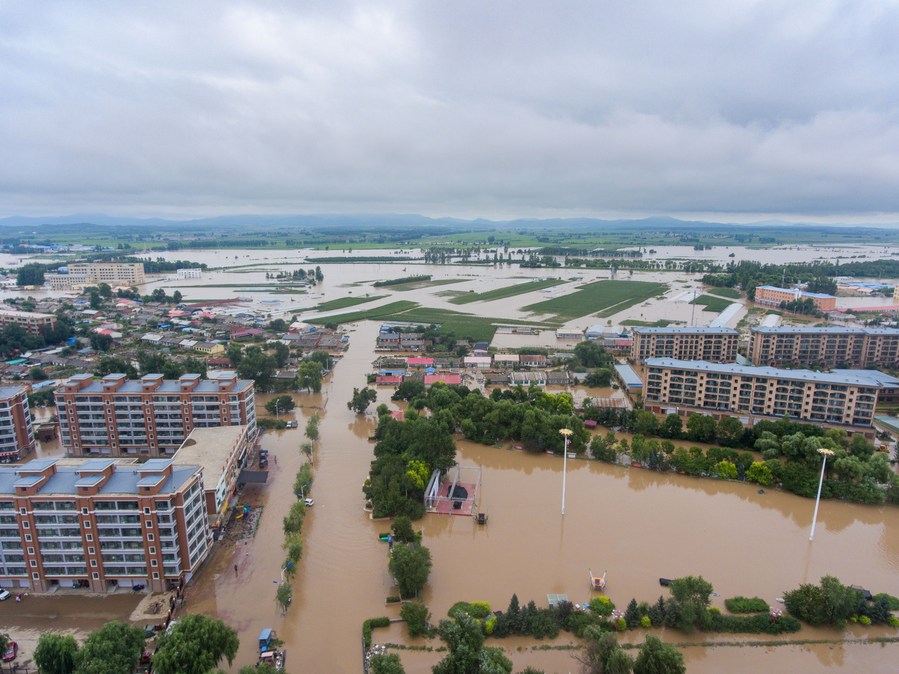
This aerial photo taken on Aug 5, 2023 shows flooded areas in Yanshou county of Harbin, Northeast China's Heilongjiang province. [Photo/Xinhua]
Experts involved in the development of China's high-standard farmland have called for more financing to increase drainage systems and weather monitoring capabilities after recent heavy rain inundated large swathes of rice fields in Northeast China.
"This round of extreme rainfall has sounded an alarm for farmland construction work in northeastern provinces," said Cai Jiumao, an irrigation expert at the Chinese Academy of Agricultural Sciences' Institute of Farmland Irrigation in Xinxiang, Henan province.
"Lessons must be learned and more focus must be shifted to enhancing farmland drainage systems," he said.
Constructing irrigation infrastructure as well as roads that allow access for farm machinery are paramount in the national drive to expand areas of high-standard farmland to make the country's food supply more resilient to droughts and take into account a rapidly aging workforce.
However, Cai said investment needs to tilt toward the less-emphasized farmland drainage system as torrential rains have become more frequent in summer.
"The investment in the construction of such fields still remains at a relatively low level in the northeast, which makes it difficult to upgrade drainage ditches that are mostly dug out of dirt ground and are unpaved," he said.
The urgency to do so was highlighted this month by downpours caused by typhoons Doksuri and Khanun, which damaged crops in two rice-producing towns in Heilongjiang and Liaoning provinces.
The torrential rains hit a month before harvest season, with grassroots authorities trying to salvage crops by pumping water from fields and bringing in agricultural specialists.
The black soil of Northeast China, which accounts for about one-fourth of the country's annual grain output, is home to large areas of high-standard farmland developed under a national project to promote large-scale mechanized farming and bolster crop resilience against natural disasters.
The cost of developing high-standard farmland is lower in the northeast regions, a fact which has drawn the attention of experts tracking the construction of such farmland.
During this year's gathering of the National People's Congress, China's top legislature, in Beijing in March, Han Qiuxiang, a lawmaker from Liaoning, told media that the average investment in every hectare of high-standard farmland in the province is only about 19,500 yuan ($2,670).
Han said the amount needs to be increased given the province's significance in safeguarding the country's food security.
Cai, from the Institute of Farmland Irrigation, said the amount was far lower than the level in Henan province, a pilot zone for building such farmland, at about 60,000 yuan.
In 2021, Henan, where Cai is based, was hit by a catastrophic deluge.
The waters inundated the provincial capital Zhengzhou, flooding the subway and leaving hundreds dead or missing, while large swathes of crops in rural areas were destroyed.
Cai said the disaster was a turning point in the province's strategy and it established new farmland and upgraded existing farms.
More emphasis was placed on flood-drainage capability by setting requirements such as restored farmland needing to withstand "once-in-a-decade" rains.
A farmland monitoring system, using a web of cameras and sensors to track data relating to a range of agricultural issues such as pests and soil moisture, also made it possible to detect risky situations and respond earlier.
"These changes had proved useful this year, as heavy downpours ravaged many northern provinces including Henan," Cai said.
Gou Tianlai, a professor at Beijing University of Agriculture, said that given the increase in extreme weather patterns, it's important to take climate factors into consideration when selecting sites for farmland.
"To fulfill quotas, authorities in some places decided to upgrade land tucked away in mountains, which harms geological structures and makes upgraded farmland susceptible to floods and other disasters," he said.
"Extreme weather is expected to increase, and that means investment must avoid disaster-prone regions," Gou added.
In 2021, China unveiled a plan to increase its area of high-standard farmland to 71.67 million hectares by 2025 and 80 million hectares by 2030.
In an interview with Beijing News, Kong Xiangbin, a professor at China Agricultural University, advocated more financing for the establishment of farmland in breadbasket provinces in Northeast China, as well as a nationwide "health check" for existing projects.
"Our field research has found that some high-standard farmland does not fully meet the criteria," he said.
"Some farmland is called high-standard simply by building a road or digging a well. However, in reality, high-standard farmland should have the ability to be irrigated during droughts and drained during floods, which requires comprehensive water conservancy facilities for farmland," he added.
链接:Experts: More drainage, finance needed for farms - Chinadaily.com.cn
